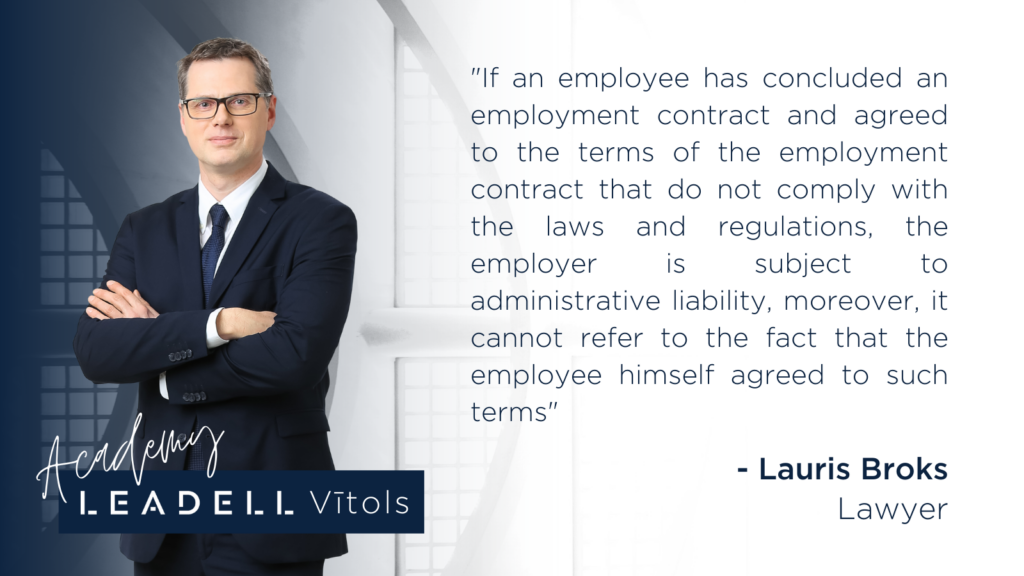News
Can an employee work seven days a week? | LEADELL Academy
In the framework of cooperation with the magazine iTiesibas, Lauris Broks – LEADELL Vītols lawyer – analyzes whether it is possible to agree that an employee works seven days in a row from 8:00 a.m. to 8:00 p.m. with a two-hour break, followed by seven days off.
Is it sufficient for the employer and the employee to agree on working hours?

Paragraph One, Section 6 of the Labor Law (LL) stipulates that provisions of an employment contract that, contrary to laws and regulations, erode the legal status of an employee, shall not be valid. The employer is obliged to ensure compliance with the laws and regulations governing employment legal relations, therefore even if the employee has concluded an employment contract and agreed to the terms of the employment contract that do not comply with the laws and regulations, the employer cannot rely upon the fact that both parties have signed the contract and the employee has agreed to such terms of the contract. For the violation of the laws and regulations governing the employment relationship, Section 162 LL provides for the employer’s administrative liability. Accordingly, the working hours specified in the employment contract must not in any case conflict with the laws and regulations governing employment legal relations.
What are the regular working hours?
Paragraph One, Section 131 LL stipulates that the regular daily working time of an employee may not exceed eight hours, and the regular weekly working time – 40 hours. Paragraph One, Section 133 LL provides that a working week of five days is set for an employee. If it is not possible to determine a working week of five days due to the nature of the work, an employer, after consultation with the representatives of employees, shall specify a working week of six days.
What would an agreement on working seven working days in a row from 8:00 a.m. to 8:00 p.m. violate?
If an employee would be working 10 hours a day and 70 hours a week, both the regular daily working time and the regular weekly working time established in Paragraph One, Section 131 LL, as well as the length of a working week set in Paragraph One, Section 133 LL would be exceeded.
Is there another type of accounts of working time?
Per Paragraph One, Section 140 LL, if due to the nature of the work it is not possible to comply with the length of the regular daily or weekly working time determined for the relevant employee, the employer, after consultation with the representatives of employees, may determine aggregated working time so that the working time in the accounting period does not exceed regular working time determined for the relevant employee. Henceforth, the law allows for the possibility to deviate from the regular daily or weekly working hours by determining the aggregated working time, but only in the case when it is impossible to observe them due to the nature of the work.
What should be taken into account when determining aggregated working time?
- pursuant to Paragraph Two, Section 140 LL the length of daily and weekly rest time laid down in the law (the duration of daily rest in a 24-hour period must not be shorter than 12 consecutive hours, while the duration of weekly rest in a seven-day period must not be shorter than 42 consecutive hours) may not be applied within the framework of aggregated working time only in the cases specified in the mentioned norm;
- pursuant to Paragraph Four, Section 140 LL it is prohibited to employ the employee for more than 56 hours a week in any case within the framework of the aggregated working time;
- pursuant to Paragraph Six, Section 140 LL, if aggregated working time is set, an employer shall assure that during the accounting period the weekly rest time shall not be shorter than 35 hours a week on average, including the daily rest time.
Are there any limits to aggregated working time?
If an employee would be working seven days in a row and 70 hours a week as part of the aggregated working time, provisions of Paragraph Four, Section 140 LL, which stipulates that in any case it is prohibited to employ an employee for more than 56 hours per week, and Paragraph Six, Section 140 LL that determine the employer’s obligation to ensure that during the accounting period the weekly rest time is not shorter than an average of 35 hours per week, including the 24-hour rest time, would not be complied with.
In light of the above, in any case, the terms of an employment contract, which would provide for a seven-day work week every day from 8:00 a.m. to 8:00 p.m. with a two-hour break at work followed by a seven-day rest period would be contrary to the norms of LL and would erode the employee’s legal status. Consequently, such terms of the employment contract would be invalid according to Paragraph One, Section 6 LL.
What to do in case of uncertainties?
LEADELL Vītols team actively provides professional support in labor law matters to clients. Entrust these and other labor law issues to us: riga@leadell.com
Lawyer Lauris Broks shared his knowledge at the LEADELL Academy and he would be pleased to help you in finding solutions to issues arising from employment relations.
Read more:
https://leadell.lv/en/two-notices-for-one-employee-22092022/
https://leadell.lv/en/allowance-for-a-business-trip-as-part-of-a-wage/
https://leadell.lv/en/annual-leave/
Categories
-
Work Disputes | Dispute Resolution
01.08.2024LEADELL -
3 Correct Ways to Assign Employees for Storm Damage Cleanup | LEADELL Academy
01.08.2024LEADELL -
1. Company Registration Status | 8 Step Guide
12.06.2024LEADELL
Latest News
Subscribe to Leadell's Newsletter







